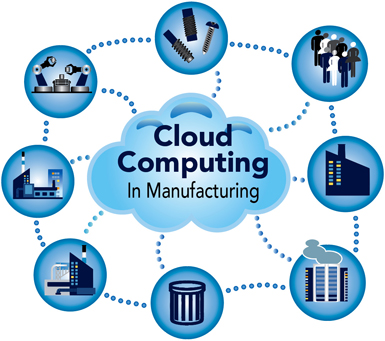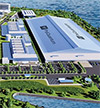Cloud Computing’s Effect on Manufacturing
Initially used for accessing and sharing data, cloud computing now allows manufacturers to connect machines, materials, and people in real time.
Directory 2016

At each plant, “the people on the lines were writing down things like how many parts they made, how many were scrap, what problems they had with the machines, etc.,” says Paul Wright, director of IT for Accuride, which makes wheels, wheel-end components, and other products for commercial vehicles. Those pieces of paper were then used to write numbers on a board every hour, and then entered once a day into an Excel spreadsheet, which was then used on a daily basis to create reports for management; these were then transposed on a monthly basis into PowerPoint.
The cloud triggers a mind-shift to ‘How do I get full value?’ It’s part of a very general trend — using information to get better utilization of investments. Jim Joyce, a specialist leader for new technologies with Deloitte “We now are able to get that information directly from the machines, taking out three layers of wasted time,” Wright says. The machines, and the rest of Accuride’s operations, are linked using applications developed by Troy, Mich.-based Plex Systems. Accuride’s experience is one example of the impact cloud computing — using the Internet to remotely host software, data, and related infrastructure — is having on manufacturing. At earlier stages of the cloud’s evolution as a business tool, manufacturers mainly used it for the same kinds of functions as other industries — accessing and sharing data. But, as software developers have created more, industry-specific applications, one of its most important capabilities for manufacturers has become real-time connectivity among machines, materials, peoples, tools, and systems on the shop floor.
Catalyst for Revolution in Manufacturing
Jim Joyce, a specialist leader for new technologies with Deloitte, says cloud technology has been the catalyst for “a revolution that is going on in manufacturing; there is this substitution of information for assets, and inventory for knowledge of where certain manufacturing capabilities, which you can access, may be…Increasingly, supply chains are designed to move information, and not physical products. As that digitization of manufacturing and the supply chain evolves, one of the key elements is going to be the cloud.” For manufacturing managers, Joyce says, the cloud triggers “a mind-shift to ‘How do I get full value?’ It’s part of a very general trend — using information to get better utilization of investments.”
For manufacturers, the cloud “opens up endless possibilities” for networking and sharing resources, says Gavin Davidson, Industry Lead for Manufacturing for cloud software developer NetSuite, Inc. Davidson says the cloud has introduced the concept of “location irrelevance” to manufacturing. It’s the concept that “it should not matter where the product stays, whether you make it or somebody makes it for you. You should be able to expect the same amount of information from the supplier and the manufacturing process as if you were making it yourself. You can get daily or hourly feedback on how many (units) are made, how many are scrapped, how efficient the machinery is...” The cloud has equal value as a quality-improvement tool, Davidson notes, enabling the user to “take your best practices established in your own facility and share them with your suppliers, so you end up with the same quality.”
Davidson cites a couple of examples drawn from NetSuite’s customer base. One is a Dallas-based manufacturer of fasteners who can monitor and control operation of manufacturing facilities in Cleveland and Los Angeles. “The guy in Dallas has complete control to run the two facilities and never has to visit there,” he says. Another company, a large carpet manufacturer, remotely operates and monitors a large production facility in China from its location in the U.S.
Using Tech Solutions Across the Enterprise
The cloud’s present and future impact was a prime topic of discussion at a recent National Association of Manufacturers board meeting, says Brian Raymond, NAM’s director of Technology and Domestic Economic Policy. “It’s become a transformative technology, bringing about transformative opportunities. The Internet of things has become almost ubiquitous, says Raymond, “and part of the business strategy of all manufacturers is figuring out how the Internet of Things is going to change competition, and change your company.”
The cloud has introduced the concept of “location irrelevance” to manufacturing. It’s the concept that it should not matter where the product stays, whether you make it or somebody makes it for you. You should be able to expect the same amount of information from the supplier and the manufacturing process as if you were making it yourself. Gavin Davidson, Industry Lead for Manufacturing for cloud software developer NetSuite, Inc. Raymond says other questions being asked across the industry include “how we can use tech solutions across the enterprise, the shop floor or embedded in products, to deliver better products, reduce costs, and increase safety — all the things technology has brought to other industries. The cloud is enabling manufacturers to take more advantage of technology.”
Adoption is growing rapidly. Earlier this year, market research firm International Data Corp. predicted that public cloud computing would reach almost $70 billion worldwide in 2015, with the top five verticals (“discrete” manufacturing, banking, professional services, process manufacturing, and retail) accounting for approximately 45 percent of the total spent. Take the example of Accuride: The company launched cloud ERP (enterprise resource management) at its corporate office in January 2013 and began rolling out its cloud manufacturing system in January 2014, according to Paul Wright. Accuride initially used the cloud to link with its Henderson, Ky., plant and subsequently its manufacturing facilities in Erie, Pa.; London. Ont.; Monterrey, Mexico; Batavia, Ill.; Rockford, Ill.; and Camden, S.C.
The apps have replaced seven different ERPs, Wright notes. “Using web-based tools, we’re able to understand manufacturing performance in real time, directly connected to the machines…The level of visibility we have is almost like being on the factory floor. Every time one of our machines cycles to produce a part, that signals across our ERP system that raw material has been consumed, and sends that signal through the cloud. We have full visibility, so we can measure operational performance based on that data.”
The system also extends to Accuride’s supply chain, with online portals the company’s suppliers can use to see and fulfill their material orders. “We can ‘see’ the product when they are preparing to ship it, and see it in transit,” Wright says. The real-time visibility is very valuable for lean and just-in-time supply chain logistics, “when you have extended lead time in bringing a product from overseas,” he explains.
Of course, data security is also a key concern, and — especially in the earlier stages of server-based data-sharing — kept many companies from going all-in. But manufacturers and vendors say today’s cloud systems have proven their ability to safeguard data. “When we’re connecting to the cloud, all we have to do is maintain our firewall integrity; we’re not responsible for management of all that data,” Wright says. “We’ve put it in the hands of people who do that professionally, which is even safer than hosting our own system.”
Small Companies Also Benefit
Relatively small manufacturing companies are also using the cloud. Bozeman, Mont.-based Mystery Ranch, a manufacturer of high-end backpacks and backpacking accessories, uses cloud software to run every part of its operations: design and engineering, production, quality control, research and testing, manufacturing, inventory management, employee management, financials, vendor relations, e-commerce, sales and marketing.
The cloud-based function that has helped Mystery Ranch the most enables the company to manage operations at five contract manufacturing locations in the U.S., Vietnam, and the Philippines, says Kendra Clark, Mystery Ranch’s IT project manager. The cloud-based system “provides visibility of consumption of raw materials, also time-stamps what products have been completed, and either ships products direct to customers or transfers them here for direct sales. Overseas manufacturing operations can be challenging for a number of reasons,” she notes, citing a typical lead-time of six to nine weeks for ordering materials. But “having the cloud has enabled us to work smarter, not harder.”
According to Jim Joyce at Deloitte, “Smaller companies tend to get involved in cloud manufacturing out of economic necessity; they may not have the capital to purchase certain equipment. Large companies are motivated by fairly sophisticated financial calculations on return on assets.”
Obviously, the remote-management capability enabled by cloud computing should have major implications for companies’ real estate and facility management strategies and location decisions. What those will be remains to be seen, since the cloud’s ramifications are only just beginning to play out. One possibility would be “pop-up” or mobile manufacturing facilities, which companies could deploy to gain proximity to customers — especially those in foreign markets — or suppliers.
Joyce’s advice for manufacturing companies: “This is the future; the digitization of physical assets, taking advantage of underused assets to lower your costs. This is something everyone should, at the very least, keep an eye on, and possibly even run a couple of experiments to teach their organizations about it.”
Project Announcements
Shapeways Holdings Expands Livonia, Michigan, Operations Complex
07/07/2023
Germany-Based Becker Robotic Equipment Plans Canton, Georgia, Manufacturing Complex
12/07/2022
LEGO Group Plans Chesterfield County, Virginia, Manufacturing Plant
06/17/2022
Scotland-Based PowerPhotonic Plans Sahuarita, Arizona, U.S. Headquarters-Production Campus
04/04/2022
A. Duie Pyle Plans Manassas-Richmond-Roanoke, Virginia, Cross Dock Service Centers
03/15/2022
Black Buffalo 3D Corporation Relocates-Plans Smithfield Township, Pennsylvania, Manufacturing Complex
02/07/2022
Most Read
-
Run a Job Task Analysis
Q4 2024
-
The Location Economics of Advanced Nuclear
Q1 2025
-
39th Annual Corporate & 21st Annual Consultants Surveys: What Business Leaders and Consultants Are Saying About Site Selection
Q1 2025
-
NEW NIMBYism: A Threat to The U.S. Economy
Q4 2024
-
Power, Policy, and Site Selection in 2025
Q1 2025
-
Designing Beyond the Assembly Line
Q1 2025
-
Why Workforce Readiness Can’t Wait
Q1 2025



